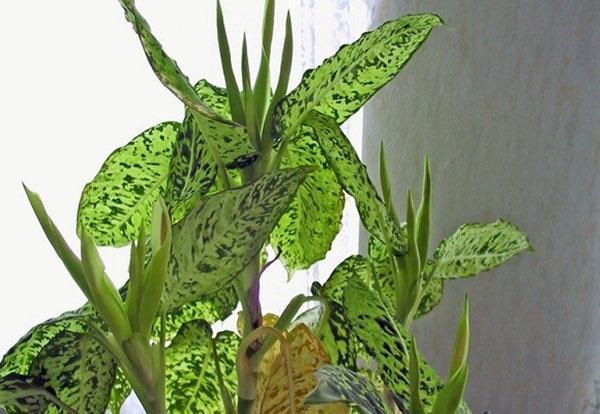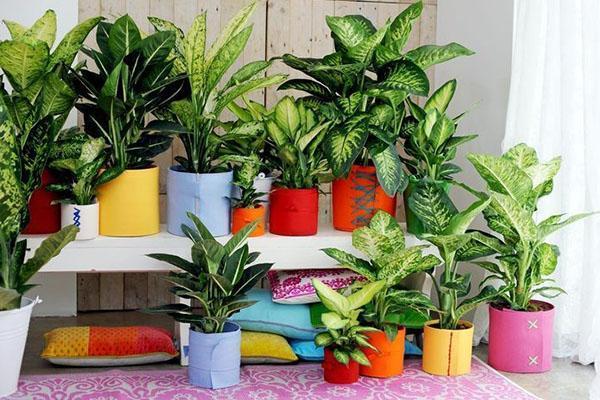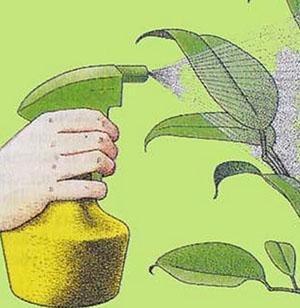Home care for dieffenbachia
 An evergreen, unpretentious dieffenbachia plant, home care requires minimal. When placing a flower, you must provide security measures. The beauty's milky secretions are toxic to children and animals. Even in an adult, dieffenbachia juice can cause blindness or laryngeal edema. There are many species in nature, but only a few varieties are used in culture. Only dieffenbachia (photo) pleasantly shade-tolerant and tolerates dry air in apartments with central heating.
An evergreen, unpretentious dieffenbachia plant, home care requires minimal. When placing a flower, you must provide security measures. The beauty's milky secretions are toxic to children and animals. Even in an adult, dieffenbachia juice can cause blindness or laryngeal edema. There are many species in nature, but only a few varieties are used in culture. Only dieffenbachia (photo) pleasantly shade-tolerant and tolerates dry air in apartments with central heating.
How to care for dieffenbachia at home

- location, illumination;
- soil composition and capacity requirements;
- watering and feeding;
- temperature regime;
- summer and winter maintenance;
The first step in caring for dieffenbachia will be the correct allocation of space. An east or west window without direct sunlight is suitable for her. The beauty of a flower in variegated large leaves. With a lack of light, the plant will lose the contrast in color, and the leaves will become smaller.
Watering and water procedures
 Watering Dieffenbachia for home care should be carried out only with soft water. Standing tap water and even boiled chilled water are good. The presence of magnesium and calcium salts in the water poisons the plant. Therefore, where there is scale on the kettle from drinking water, you need to look for another water. Watering the plant is necessary often, as soon as the top layer of the earth dries up.
Watering Dieffenbachia for home care should be carried out only with soft water. Standing tap water and even boiled chilled water are good. The presence of magnesium and calcium salts in the water poisons the plant. Therefore, where there is scale on the kettle from drinking water, you need to look for another water. Watering the plant is necessary often, as soon as the top layer of the earth dries up.
One of the methods of washing the earth from salts is keeping a clod of earth in water for 15 minutes. Then the water must be removed through the drainage hole. Such a procedure is needed once a month in the summer. In winter, just abundant watering is enough. If the plant is flooded, then the leaves of Dieffenbachia begin to turn brown, turn yellow, and fall off.
 Spraying the dieffenbachia flower daily in home care is beneficial. A moss tray, an evaporator, an aquarium - all this creates the right moisture around the plant.
Spraying the dieffenbachia flower daily in home care is beneficial. A moss tray, an evaporator, an aquarium - all this creates the right moisture around the plant.
During the period of active growth, Dieffenbachia needs frequent feeding with organic and mineral fertilizers... Once every 7-10 days, adding food to the irrigation water will create favorable conditions for flower development.
Dieffenbachia flower how to care for winter and summer
In summer, when the lighting is sufficient, the flower can be placed in the back of the room. The decisive factor will be not to set fire to the plants on a warm window. The increased temperature will inevitably lead to yellowing of the leaf blade. Dieffenbachia, home care requires a mild temperature change within 22 degrees in summer and 18 in winter. Drafts are unacceptable. When ventilating, the plant must be protected from a fresh stream of air. Better to move the pot to another room.
 For uniform formation of the bush, it needs lighting from all sides. Therefore, the container with the plant must be periodically turned over along the axis. With its wide leaves, Dieffenbachia absorbs harmful emissions from the air, purifying it.
For uniform formation of the bush, it needs lighting from all sides. Therefore, the container with the plant must be periodically turned over along the axis. With its wide leaves, Dieffenbachia absorbs harmful emissions from the air, purifying it.
Dieffenbachia is transplanted when leaving at home when the previous pot becomes cramped.
Purchased land is used for transplanting leafy plants or a mixture of equal shares:
- leafy land;
- peat;
- humus;
- sand.
The addition of activated birch charcoal helps in cleaning the substrate from harmful salts. The container can be used with a small margin, as the roots grow quickly. When planted, the stem deepens and gives rise to fresh roots. For quick survival, root formation stimulants must be added in the first watering.
 It is after transplantation, when the stem of the plant is exposed from the fallen leaves, it is necessary to cut the stem, leaving 10 cm on the surface. Fresh young leaves will appear on the bare part of the sleeping buds. The crown can be rooted by getting a new plant.
It is after transplantation, when the stem of the plant is exposed from the fallen leaves, it is necessary to cut the stem, leaving 10 cm on the surface. Fresh young leaves will appear on the bare part of the sleeping buds. The crown can be rooted by getting a new plant.
When caring for dieffenbachia, protective equipment must be used. When pruning a plant, remember that the cuts are poisonous, and the remains during work must be packed before throwing them into household waste.
Failure to comply with the conditions for keeping a flower leads to a change in the leaves, their yellowing or falling off. It is necessary to find the cause of the disease. If the disease is physiological, eliminate the cause, and the new leaves will be healthy. Remove old plates over time.
Diseases and pests of dieffenbachia
 It should be noted that diseases and pests can colonize the flower if dieffenbachia care does not meet the requirements. A strong plant itself resists disease. Of course, you can populate insects from a neighboring flower or use the land with live mycelium of the fungus for transplantation, but this only means that the care of plants on the windowsill is broken.
It should be noted that diseases and pests can colonize the flower if dieffenbachia care does not meet the requirements. A strong plant itself resists disease. Of course, you can populate insects from a neighboring flower or use the land with live mycelium of the fungus for transplantation, but this only means that the care of plants on the windowsill is broken.
Signs of fungal diseases are the appearance on the leaves of uncharacteristic spots, stripes, weeping and drying edges of the leaves.
When decaying, the root system cannot provide the plant with food, yellowness appears on the leaves.
 This is made possible by diseases such as:
This is made possible by diseases such as:
- anthracosis;
- fusarium;
- viral damage.
Anthracosis affects the upper part of the plant. The appearance of dry spots that enlarge and destroy the leaf is the most common manifestation of the disease. Spores can enter with irrigation water. The disease provokes dryness in the room, excessive watering. You can treat it with fungicides and remove the infected parts of the plant. Normalize the containment regime.
Fusarium spreads to the roots and the entire plant. The fungus lives in the soil. Therefore, sterilization of the substrate during plant transplantation is important. You can save the plant at the earliest stage of the disease by treating it with a fungicide, cutting out the affected areas and taking new dishes and soil.
 The viral disease manifests itself as twisted leaves, a bronze tint on the top of the plant. It is carried by insects from diseased plants. The diseased plant must be destroyed. You cannot take material from him for reproduction.
The viral disease manifests itself as twisted leaves, a bronze tint on the top of the plant. It is carried by insects from diseased plants. The diseased plant must be destroyed. You cannot take material from him for reproduction.
 Insect pests that populate the flower feed on juices, spoil the appearance of the flower. If the colony grows large, it can kill the plant. Several types of pests breed on the poisonous Dieffenbachia:
Insect pests that populate the flower feed on juices, spoil the appearance of the flower. If the colony grows large, it can kill the plant. Several types of pests breed on the poisonous Dieffenbachia:
- spider mite;
- aphid;
- shield;
- mealybug.
Measures to combat them are known - first, soapy water, later - insecticides.
Deovchki help what kind of diphenbachia to buy? We are in the office, it is not sunny, we will water)) the temperature is normal, but not the sunny side
You can buy adorable dieffenbachia - it tolerates a lack of lighting best of all, and the sizes are suitable for an office.